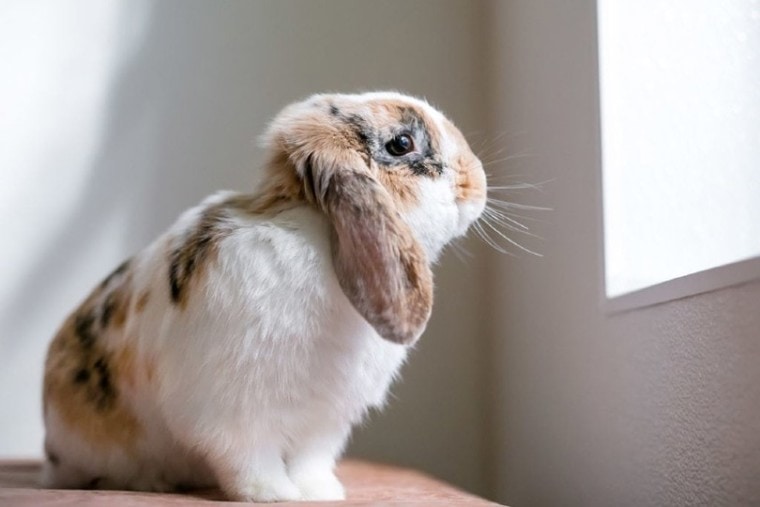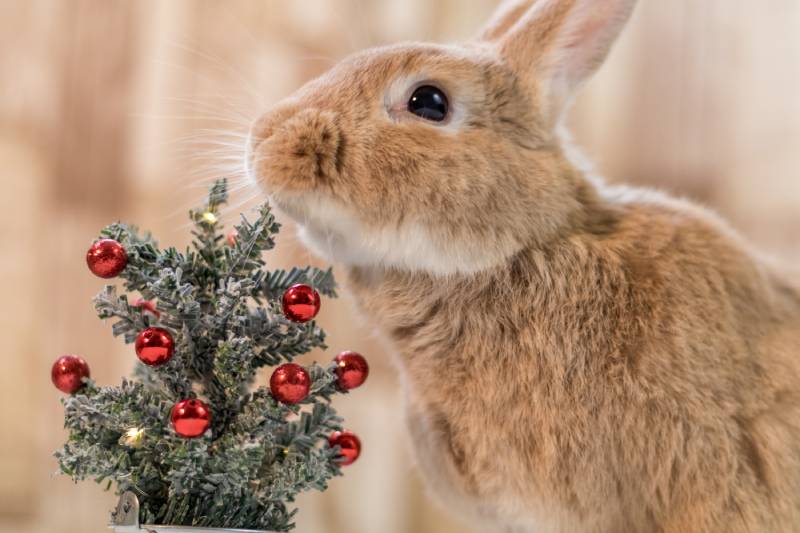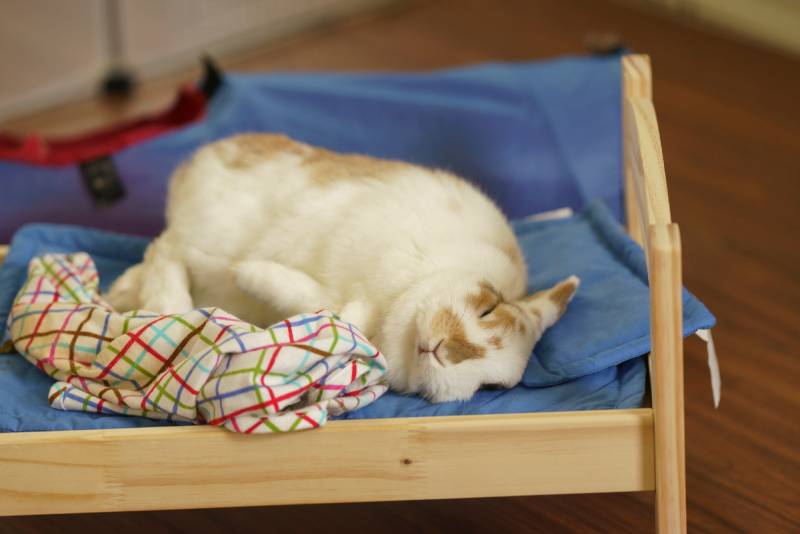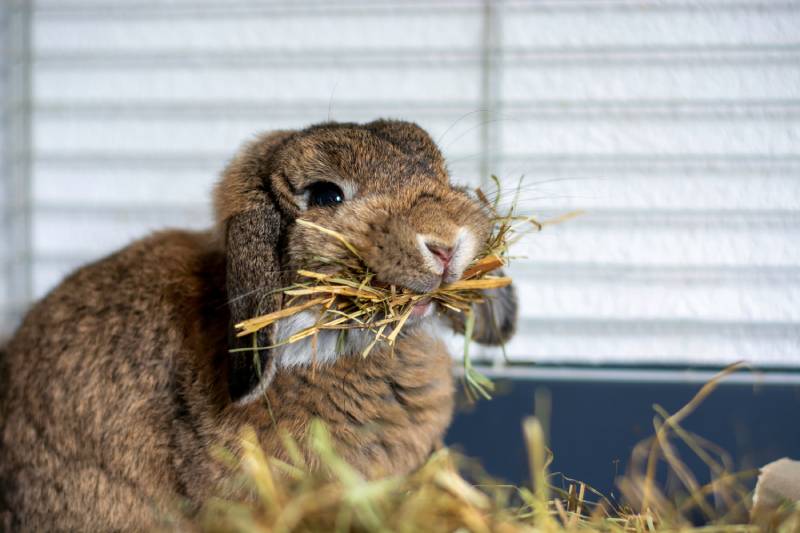
Many breeds of rabbits have been domesticated as pets, and today, they’re the 3rd-most-popular pet in the United States. While pet rabbits can be kept outdoors if provided with the correct environment, many owners choose to keep their furry friends indoors where they can interact and engage with them more easily.
If you plan to adopt a rabbit and wish to keep it indoors, the information below will help you make your rabbit feel right at home. Read on to discover the important things to know about keeping a rabbit indoors and start your relationship with your new carrot muncher on the right foot!
The 12 Tips to Keep Your Rabbit Indoors
1. Expect Your Rabbit to Engage in Chinning
When you have a pet rabbit, one of the activities you might see it engage in is rubbing its chin against different objects and people. This activity, called chinning, isn’t for pleasure but to allow the rabbit to leave its mark, much like a dog urinates or a cat sprays. Rabbits have a specialized gland under their chin that allows them to do this. When they rub their chin against something, including other rabbits and people, this special gland releases a scent that is undetectable to humans. What’s truly fascinating, however, is that every rabbit has its own unique scent, much like a human fingerprint.

2. A Standing Rabbit is Likely Scanning for Danger
When their pet rabbit stands up on its hind legs, many owners believe it’s trying to get attention or engage with them. However, this activity is typically performed when a rabbit scans the area for danger, including predators. You might find that surprising considering that your rabbit is being kept indoors, but as a prey animal, a rabbit’s instincts are incredibly strong. Those instincts tell them to constantly scan for danger, even in the relative safety of a house. This behavior is usually reduced the longer a rabbit is housed with the same individual human and feels safer in their environment.
3. Flopping to Sleep Is 100% Normal for a Rabbit
It’s common for rabbits to sleep standing up because, as prey animals, they must be able to dash off at a split-second’s notice to escape predators. This, of course, is instinctive and common to all rabbits. However, when your rabbit feels exceptionally safe and secure living with you, you’ll notice that it “flops” to sleep. That’s when a rabbit flops over and falls asleep almost immediately on its side or back. Many pet owners who see their rabbit flop to sleep for the first time mistakenly believe their pet has fainted. The fact, however, is that if your rabbit is flopping to sleep, it trusts you implicitly and feels very safe.

4. Head Butting Is a Rabbit’s Way of Asking to Be Groomed or Petted
Like chinning, head-butting is an activity that you may notice your rabbit engaging in occasionally. Head-butting is a method rabbits use to tell other rabbits they want to be groomed. If you have more than one rabbit at home, you might see them head-butting each other occasionally, which is nothing to worry about. Some rabbits will head butt or nudge their owners for the same reason or to encourage their favorite human to pet them.
5. Your Rabbit Needs a Constant Supply of Fresh Hay
Not only do rabbits eat a lot of hay, but they also do it for several specific reasons. The first is that eating a constant supply of hay helps keep a rabbit’s digestive system healthy and functioning correctly. The second is that eating hay helps a rabbit trim its teeth. If it doesn’t have enough hay to eat and trim them, your rabbit’s teeth will grow longer until they cause several health problems.

6. A Paper-Based Litter Is Best for Your Rabbit’s Litter Box
Although it’s relatively easy to train a rabbit to use a litter box, you must purchase litter that’s suitable for them. Many cat litters, especially those made from clay or softwood, can make your pet rabbit sick. Breeders recommend using paper-based litter made from natural or organic materials. You can also line your rabbit’s litter box with newspaper and put hay on top. If you use the latter method, be sure to constantly replace the hay.
7. To Prevent Chewing, Keep Your Rabbit Occupied
Just like a dog that becomes bored when left alone, your rabbit might chew or dig when it has nothing to do, often destroying your things in the process. That’s why, just like with a dog, you should ensure your rabbit has plenty of rabbit-specific toys to play with and stay physically and mentally engaged. One excellent suggestion is to fill a paper towel roll with hay and give that to your rabbit as a plaything. It will keep them occupied and give your pet something yummy and healthy to munch on.

8. Experts Recommend Against Giving Your Rabbit Free Reign in Your Home
While you can allow your rabbit to roam freely in your home, veterinarians and animal experts recommend against it. That’s because rabbits thrive in a space they can call their own, including an area where they can stretch, move around and burrow into when they want to relax. Some rabbit owners prepare an entire area of one room for their rabbits and put up barriers to keep them in that space. Others give their pets an entire room to themselves, but many owners don’t have that luxury. Your best choice is to purchase a hutch that’s large enough for your rabbit to move around freely and not feel too confined.
9. Your Rabbit Needs a Constant Supply of Fresh Water
Like all animals and pets, a rabbit needs water to drink, thrive, and survive. You should ensure that your rabbit has water available to drink 24 hours a day and that you refresh their water daily. Most rabbit owners use a large water bottle with a straw that they attach to their rabbit’s hutch. Using a low-rimmed, heavy water bowl is also possible, but you’ll need to attach the bowl securely to prevent your rabbit from constantly tipping it over and spilling the water.

- Related Read: How to Feed a Baby Rabbit (And What to Feed Them)
10. Your Rabbit’s Hutch Must Be Taller than They Are
As mentioned earlier, it’s normal for a rabbit to stand on its hind legs while it scans for danger and predators. Because of that, any hutch you purchase for your rabbit must be taller than your pet when standing on its hind legs. That way, when your rabbit scans the room, it doesn’t hit its head. It’s also best to purchase a hutch with a wooden or metal base but not one made from chicken wire. Walking around on chicken wire all day, every day, can cause injuries to your rabbit’s hocks.
11. You Must Rabbit-Proof Your Home if Your Rabbit Runs Freely
Just as you would for a dog or cat, you must rabbit-proof your home if you plan to give your pet free-reign in your house. That includes removing toxic plants and anything else that could harm them. It also includes securing the wires in your home since rabbits may chew on them.

12. Your Rabbit Needs to Run Around Outside of Its Cage
The last important thing to know about keeping a rabbit indoors is that you should let your pet run outside its hutch at least once a day. A rabbit that’s kept in its hutch all the time will often suffer from behavioral disorders and might even injure itself. Allowing your pet to run around in a controlled area outside of its pen is thus essential to your rabbit’s health.
Final Facts about Keeping a Rabbit Indoors
As the 3rd-most popular pet in the United States, you’ll find rabbits in many American homes. Experts recommend keeping your pet rabbit indoors as long as you follow and understand the important tips covered in this article. If you do, you and your furry rabbit friend will have a long and fascinating life together.
Featured Image Credit: New Africa, Shutterstock








